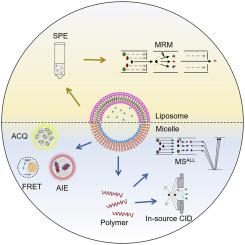Journal of Pharmaceutical Analysis ( IF 6.1 ) Pub Date : 2020-05-16 , DOI: 10.1016/j.jpha.2020.05.002 Tingting Wang 1, 2 , Di Zhang 2 , Dong Sun 3, 4 , Jingkai Gu 2, 5

|
The development of nano drug delivery systems (NDDSs) provides new approaches to fighting against diseases. The NDDSs are specially designed to serve as carriers for the delivery of active pharmaceutical ingredients (APIs) to their target sites, which would certainly extend the benefit of their unique physicochemical characteristics, such as prolonged circulation time, improved targeting and avoiding of drug-resistance. Despite the remarkable progress achieved over the last three decades, the understanding of the relationships between the in vivo pharmacokinetics of NDDSs and their safety profiles is insufficient. Analysis of NDDSs is far more complicated than the monitoring of small molecular drugs in terms of structure, composition and aggregation state, whereby almost all of the conventional techniques are inadequate for accurate profiling their pharmacokinetic behavior in vivo. Herein, the advanced bioanalysis for tracing the in vivo fate of NDDSs is summarized, including liquid chromatography tandem-mass spectrometry (LC-MS/MS), Förster resonance energy transfer (FRET), aggregation-caused quenching (ACQ) fluorophore, aggregation-induced emission (AIE) fluorophores, enzyme-linked immunosorbent assay (ELISA), magnetic resonance imaging (MRI), radiolabeling, fluorescence spectroscopy, laser ablation inductively coupled plasma MS (LA-ICP-MS), and size-exclusion chromatography (SEC). Based on these technologies, a comprehensive survey of monitoring the dynamic changes of NDDSs in structure, composition and existing form in system (i.e. carrier polymers, released and encapsulated drug) with recent progress is provided. We hope that this review will be helpful in appropriate application methodology for investigating the pharmacokinetics and evaluating the efficacy and safety profiles of NDDSs.
中文翻译:

纳米药物递送系统体内生物分析的现状。
纳米药物输送系统(NDDS)的发展为对抗疾病提供了新方法。 NDDS经过专门设计,可作为将活性药物成分(API)递送至靶位点的载体,这肯定会扩展其独特的理化特性的优势,例如延长循环时间、提高靶向性和避免耐药性。尽管在过去三十年中取得了显着的进展,但对 NDDS 体内药代动力学与其安全性之间关系的了解还不够。 NDDS 的分析在结构、组成和聚集状态方面比小分子药物的监测复杂得多,因此几乎所有常规技术都不足以准确分析其体内药代动力学行为。本文总结了追踪 NDDS 体内命运的先进生物分析技术,包括液相色谱串联质谱 (LC-MS/MS)、福斯特共振能量转移 (FRET)、聚集引起的猝灭 (ACQ) 荧光团、聚集-诱导发射 (AIE) 荧光团、酶联免疫吸附测定 (ELISA)、磁共振成像 (MRI)、放射性标记、荧光光谱、激光烧蚀电感耦合等离子体 MS (LA-ICP-MS) 和尺寸排阻色谱 (SEC) 。基于这些技术,提供了监测NDDS在结构、组成和系统中存在形式(即载体聚合物、释放和封装的药物)动态变化的全面综述,并取得了最新进展。 我们希望本次综述将有助于采用适当的应用方法来研究 NDDS 的药代动力学并评估其功效和安全性。











































 京公网安备 11010802027423号
京公网安备 11010802027423号